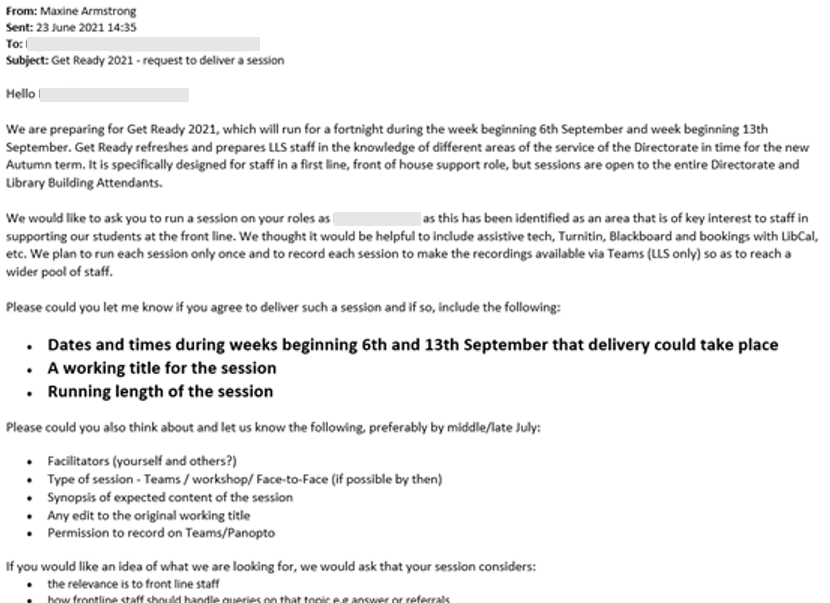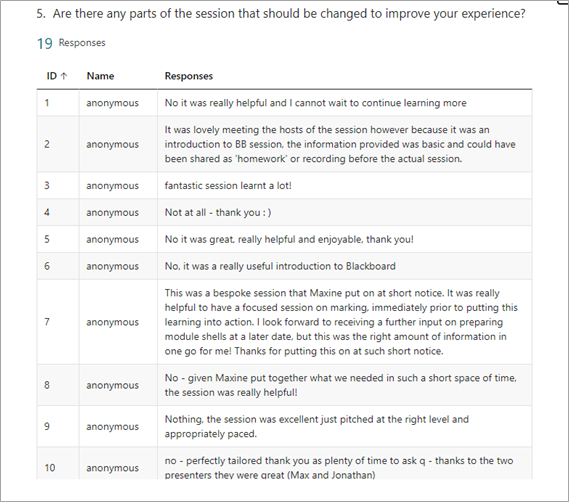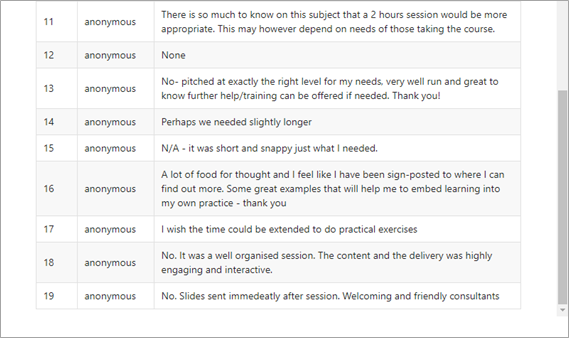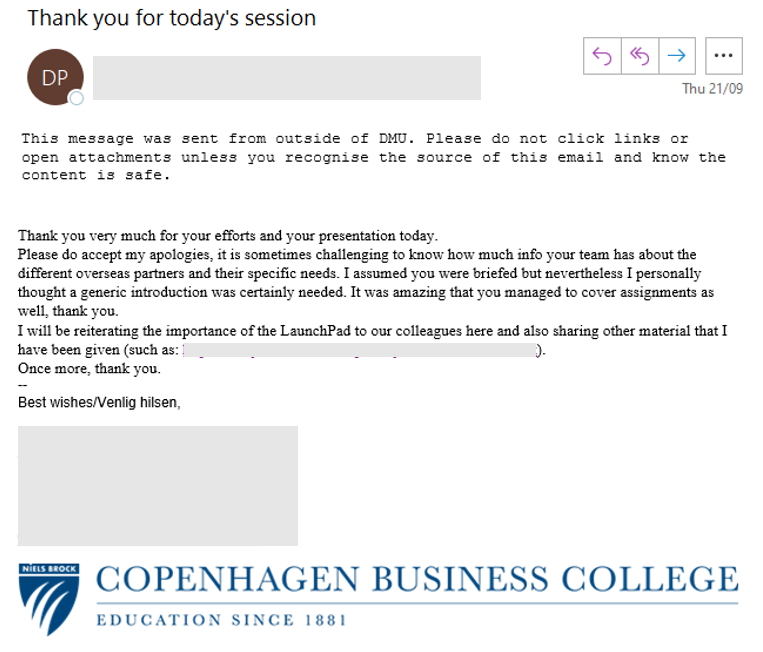My job role regularly involves working with others and communicating effectively. For example, during the summer of 2020 and 2021 I was part of the Get Ready Team for the Library and Learning Services (LLS) which prepares a fortnight of events each September to prepare colleagues in the directorate for the new academic year. As a Get Ready team member, I contacted colleagues to ask if they might be willing to contribute, for example, a skills sharing or best practice training session or presentation (figure 12). While the events were running, I also helped facilitate and record sessions making them available afterwards.
The screenshot (figure 12) below shows an email I sent to request support on behalf of the Get Ready team.
Another recent example of my collaborative working was co-developing LaunchPad. Launchpad is a self-enrol module on our new VLE, LearningZone, which was created to provide a compulsory self-paced module for all academic and relevant professional service staff who need to use LearningZone. The module provides guidance and includes areas for pedagogic exploration and reflection-on-practice.
All members of the DLAT team have contributed content and aided in its development and testing. I was responsible for writing the second unit on Module Set-Up and Content Creation. I included step-by-step guidance on how to add content to LearningZone. This involved creating animated gifs to demonstrate the steps and creating activities for users to practice and consolidate their skills.
I also helped the team by proofing and correcting the Assessment unit and creating many screenshots and images that other colleagues used to produce their own portion of the learning materials for this unit in Launch Pad.
I have previously mentioned (Core area 1c) how I have facilitated the Build A Module workshops. These workshops provide targeted support to academic colleagues on how they can initially set up a basic module shell and then enhance it to fully engage their students. These sessions are informal and often generate a lively debate about what is best practice and what works well for different disciples.
Whenever I run a training workshop, I recommend participants work though the LaunchPad units and after all my workshops I send a follow up email that recaps key content from the workshop and also points them to additional opportunities and resources to develop their skills further. For example, when I ran two sessions on how to add release conditions to cohort groups within a LearningZone module, in my follow-up email I recommended that they reviewed release conditions in more detail. To help me improve my training skills, I always ask for feedback from participants. For example, the screenshots below (see figures 13 and 14) shows responses from the feedback evaluation form I send using MS Teams.
Prior to LearningZone I contributed to the DLAT team blog by submitting a number of articles that focussed on different technologies. (This blog has not been used during the transition to a new VLE as there have been other avenues of communication with our colleagues that have taken precedence. When the transition to the new VLE has been completed the team will discuss whether to reintroduce a regular blog for staff.)
Reflecting on the workshops that I have provided for LearningZone, has greatly increased my knowledge of the new VLE. I have facilitated 12 sessions for our TNE partner institutions since July 2023, as well as providing central sessions for academic colleagues at our Leicester campus. When running the Deep Dive sessions – on topics from Communication to Online Phase Tests – or even the more basic introductory sessions, I have to be prepared to answer some quite nuanced queries. When I have provided sessions, I have to be flexible as often the participants want different or additional guidance to the session scheduled. The following email (figure 15) illustrates how much academics value this adaptable approach. As this particular colleague writes, “Thank you very much for your efforts and presentation today … it was amazing that you managed to cover assignments as well, thank you”.
The Build-A-Module sessions have been very helpful in bringing colleagues together and show how successful collaborative working can be. These sessions are often run by a group of my fellow DLAT consultants and we have colleagues from around the university attend. Some very interesting discussions can arise as people share their experiences of using LearningZone. We have been asking participants to contribute to a Padlet, Art of the Possible, to discuss how to enhance the student experience using LearningZone.
The DLAT team have been learning about LearningZone at the same time as we have been creating the training material for to teach others how to use it, which is not ideal. I would have preferred to have had more time to familiarise myself with the technology beforehand. Also, when creating LaunchPad the individual unit learning objectives changed whilst we were creating the resources which meant a lot of revision. This was due to changes in the main LearningZone project as policies were being written at the same time. There were also changes as to how the LaunchPad module would integrate with the other training resources we were offering, so again it meant revisions. I think this is one occasion where we should have listened to Henrico Dolfing’s advice, “Your Projects Should Start Slow in Order to Run Fast Later” (Dolfing, 2019). Therefore, in future I would advocate that with any training support provided for a large-scale technology project we do not start training too soon and we have clear training objectives in place. This would provide us more time for development and a clearer idea of how and why the resources are going to be used and integrated with any other resources provided.
A readiness checklist was added to each unit in LaunchPad for participants to determine how ready they felt they were for using the new VLE. Learners have gained confidence in using LearningZone and the readiness checklist for the unit I created demonstrates this, with 86% of users moderately to extremely confident in setting up their modules and 85% in creating content. Providing the self-directed training module LaunchPad alongside our online and face-to-face workshops has been a success and I would advocate this multi-delivery approach in future.
Reference
Dolfing, H. (2019) Your Projects Should Start Slow in Order to Run Fast Later, 30 Jun 2019, henricodolfing [online], available at https://www.henricodolfing.com/2019/06/start-projects-slow-run-fast-later.html (accessed 29 Sept 2023)




